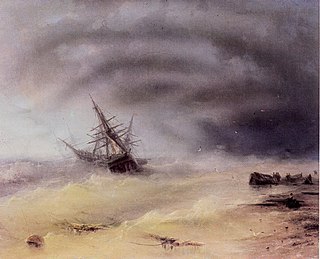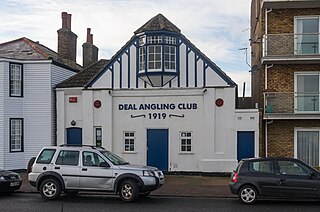Gutenburg may refer to:

Goodwin Sands is a 10-mile-long (16 km) sandbank at the southern end of the North Sea lying 6 miles (10 km) off the Deal coast in Kent, England. The area consists of a layer of approximately 25 m (82 ft) depth of fine sand resting on an Upper Chalk platform belonging to the same geological feature that incorporates the White Cliffs of Dover. The banks lie between 0.5 m above the low water mark to around 3 m (10 ft) below low water, except for one channel that drops to around 20 m (66 ft) below. Tides and currents are constantly shifting the shoals.
The Margate surfboat refers to three surfboats used for maritime rescue at Margate, on the eastern tip of Kent. They were run as cooperatives, with local boatmen clubbing together to buy them and then receiving a share of any salvage money received.

The Ramsgate tugs were a series of tugboats used at Ramsgate harbour since the 19th century. The harbour's development coincided with the growing use of the steam tugs that were then being built for the shipping industry.
The SS Cap Lopez was a 758 GRT cargo ship that was built in 1885 as Rheinland. She was sold in 1905 and renamed, and became stranded on the south Goodwin Sands on 21 December 1907.
There are several possible meanings for Guttenberg, Guttenburg or Gutenburg:
Johannes Gutenberg was a German printer who invented effective mechanical printing.

The Wells lifeboat disaster occurred in 1880 when the RNLI lifeboat Eliza Adams, based at Wells-next-the-Sea in the English county of Norfolk, attempted to go to the aid of the stricken brig Ocean Queen in heavy seas and was lost along with 11 of its 13 crew.

Walmer Lifeboat Station is located on The Strand on Walmer promenade, in the county of Kent.

The Port of Ramsgate is a harbour situated in Ramsgate, south-east England, serving cross-Channel freight traffic and smaller working and pleasure craft. It is owned and operated by Thanet District Council.

The Lady Lovibond is the name given to a legendary schooner that is alleged to have been wrecked on the Goodwin Sands, off the Kent coast of south-east England, on 13 February 1748, and is said to reappear there every fifty years as a ghost ship. No contemporary records of the ship or its supposed sinking have been found.
James Henry Haylett (1825–1907) was one of the most famous lifeboatmen of his age. Decorated by King Edward VII with the RNLI gold medal for his efforts in the 1901 Caister lifeboat disaster, which claimed the lives of nine men. Amongst those lost were two of his sons, Aaron and James Haylett, Charles Bonney George and his grandson Harry Knights.

The Caister lifeboat disaster of 13 November 1901 occurred off the coast of Caister-on-Sea, Norfolk, England. It took place during what became known as the "Great Storm", which caused havoc down the east coasts of England and Scotland.

SS Mahratta was a steamship owned by Brocklebank Line which was launched in 1891 and ran aground on the Goodwin Sands in 1909.
SS Yousuf Baksh was a 5,975-ton Pakistan registered freighter which caught fire and ran aground in May 1965.

The SS Luray Victory was the seventeenth Victory ship, a new 10,500 ton class ship built during World War II. The California Shipbuilding Company built the ship under the Emergency Shipbuilding program. She was launched on May 11, 1944, and completed on June 26, 1944. The ship’s United States Maritime Commission designation was VC2-S-AP3, hull number 17 (V-17). The SS Luray Victory served in the Pacific Ocean during World War II and was operated by the Black Diamond Steamship Company.
HM Tug Char, formally the North Eastern Railway tug Stranton, was a ship requisitioned by the Admiralty during the Great War.

Kingsdown Lifeboat Station was located on the shore off Wellington Parade, Kingsdown, a village situated at the north end of the White Cliffs of Dover, Kent.

North Deal Lifeboat Station was located on Beach Street, in the town of Deal, in the county of Kent.

Broadstairs Lifeboat Station was a former lifeboat station in Kent, England. It was rather unusual, as it never had a boathouse, although a building was provided by the Harbour Commissioners in which to store all the equipment. The lifeboat was kept under a tarpaulin, and was stored on the pier at Broadstairs, a harbour town on the east coast of Kent.